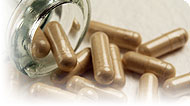D-Mannose
Uses
D-mannose is a simple sugar structurally related to glucose. It is absorbed slowly from the gastrointestinal tract, and then a large proportion of it is excreted into the urine.1
Our proprietary “Star-Rating” system was developed to help you easily understand the amount of scientific support behind each supplement in relation to a specific health condition. While there is no way to predict whether a vitamin, mineral, or herb will successfully treat or prevent associated health conditions, our unique ratings tell you how well these supplements are understood by the medical community, and whether studies have found them to be effective for other people.
For over a decade, our team has combed through thousands of research articles published in reputable journals. To help you make educated decisions, and to better understand controversial or confusing supplements, our medical experts have digested the science into these three easy-to-follow ratings. We hope this provides you with a helpful resource to make informed decisions towards your health and well-being.
3 StarsReliable and relatively consistent scientific data showing a substantial health benefit.
2 StarsContradictory, insufficient, or preliminary studies suggesting a health benefit or minimal health benefit.
1 StarFor an herb, supported by traditional use but minimal or no scientific evidence. For a supplement, little scientific support.
This supplement has been used in connection with the following health conditions:
| Used for | Why |
|---|---|
1 Star Urinary Tract Infection Refer to label instructions | D-Mannose may help treat UTIs by binding to bacteria that would otherwise attach to the urinary tract lining. Some bacteria that typically cause urinary tract infections can attach themselves to the lining of the urinary tract by binding to molecules of that naturally occur there. Theoretically, if enough D-mannose is present in the urine, it would bind to the bacteria and prevent them from attaching to the urinary tract lining. One animal study has demonstrated this protective effect, but whether it would occur in humans is unknown, and no human research has investigated the effectiveness of oral D-mannose for the prevention or treatment of urinary tract infections. |
How It Works
How to Use It
Some doctors report that D-mannose might help prevent or treat urinary tract infections caused by E. coli and recommend 1 teaspoon (5 ml) dissolved in water or juice every two to three hours while awake.2
Where to Find It
D-Mannose is in many fruits, including Peaches, apples, oranges, cranberries, and blueberries.
Possible Deficiencies
As D-mannose is not an essential nutrient, except in certain rare genetic disorders people produce sufficient amounts to provide for the bodies' needs.
Interactions
Interactions with Supplements, Foods, & Other Compounds
Interactions with Medicines
Side Effects
Side Effects
Test tube and animal studies suggest that consuming large amounts of mannose might lead to birth defects,3, 4 although the amounts of mannose used on those studies were far greater than the amounts a person would ingest from food or from a supplement to treat a urinary tract infection. Nonetheless, until more is known, pregnant women should use supplemental mannose with caution.
References
1. Herman RH. Mannose metabolism I. Am J Clin Nutr 1971;24:488-98 [review].
2. Wright JV, Lenard L. D-Mannose & Bladder Infection:The Natural Alternative to Antibiotics. Auburn, WA: Dragon Art, 2001:17.
3. Freinkel N, Lewis NJ, Akazawa S, Roth SI, Gorman L. The honeybee syndrome: implications of the teratogenicity of mannose in rat-embryo culture. N Engl J Med 1984;310:223-30.
4. Buchanan T, Freinkel N, Lewis NJ, et al. Fuel-mediated teratogenesis. Use of D-mannose to modify organogenesis in the rat embryo in vivo. J Clin Invest 1985;75:1927-34.
Last Review: 06-03-2015

Copyright © 2024 TraceGains, Inc. All rights reserved.
Learn more about TraceGains, the company.
The information presented by TraceGains is for informational purposes only. It is based on scientific studies (human, animal, or in vitro), clinical experience, or traditional usage as cited in each article. The results reported may not necessarily occur in all individuals. For many of the conditions discussed, treatment with prescription or over the counter medication is also available. Consult your doctor, practitioner, and/or pharmacist for any health problem and before using any supplements or before making any changes in prescribed medications. Information expires December 2024.
This information does not replace the advice of a doctor. Healthwise, Incorporated, disclaims any warranty or liability for your use of this information. Your use of this information means that you agree to the Terms of Use. Learn how we develop our content.

